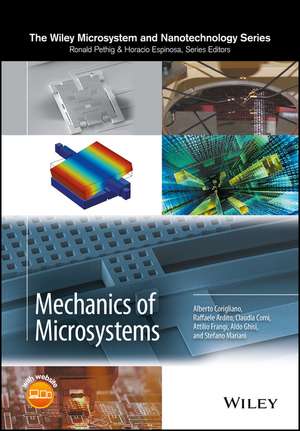Mechanics of Microsystems: The Wiley Microsystem and Nanotechnology Series
Autor A Coriglianoen Limba Engleză Hardback – 21 dec 2017
A mechanical approach to microsystems, covering fundamental concepts including MEMS design, modelling and reliability
Mechanics of Microsystems takes a mechanical approach to microsystems and covers fundamental concepts including MEMS design, modelling and reliability. The book examines the mechanical behaviour of microsystems from a 'design for reliability' point of view and includes examples of applications in industry.
Mechanics of Microsystems is divided into two main parts. The first part recalls basic knowledge related to the microsystems behaviour and offers an overview on microsystems and fundamental design and modelling tools from a mechanical point of view, together with many practical examples of real microsystems. The second part covers the mechanical characterization of materials at the micro-scale and considers the most important reliability issues (fracture, fatigue, stiction, damping phenomena, etc) which are fundamental to fabricate a real working device.
Key features:
- Provides an overview of MEMS, with special focus on mechanical-based Microsystems and reliability issues.
- Includes examples of applications in industry.
- Accompanied by a website hosting supplementary material.
The book provides essential reading for researchers and practitioners working with MEMS, as well as graduate students in mechanical, materials and electrical engineering.
Preț: 591.71 lei
Preț vechi: 852.79 lei
-31% Nou
113.24€ • 117.91$ • 95.70£
Carte indisponibilă temporar
Specificații
ISBN-10: 1119053838
Pagini: 424
Dimensiuni: 193 x 253 x 29 mm
Greutate: 0.89 kg
Editura: Wiley
Seria The Wiley Microsystem and Nanotechnology Series
Locul publicării:Chichester, United Kingdom
Public țintă
Tier 3, P&RPrimary: Researchers and practitioners (designers, etc) working with MEMS.
Secondary: Graduate students in mechanical and electrical engineering.
Notă biografică
Alberto Corigliano, Raffaele Ardito, Claudia Comi, Attilio Frangi, Aldo Ghisi, and Stefano Mariani - Politecnico di Milano, Italy
Alberto Corigliano is a Professor of Solid and Structural Mechanics at the Department of Civil and Environmental Engineering of Politecnico di Milano, Italy. A. Corigliano has authored and co-authored more than 240 scientific publications in fields related to solid and structural mechanics at various scales, including 2 book chapters in Microsystems area, and 7 patents on Microsystems. During his research activity, A. Corigliano covered a wide range of subjects in the fields of structural and materials mechanics, with particular reference to theoretical and computational problems relevant to non-linear material responses.
Raffaele Ardito is an Associate Professor of Solid and Structural Mechanics at the Department of Civil and Environmental Engineering of Politecnico di Milano, Italy. He graduated in 2000 (cum laude) at the Politecnico di Milano in Civil Engineering and he received the Ph.D. degree, cum laude, in 2004. From 2004 to 2006 he was a research fellow at the National Institute for Nuclear Physics, joining an international research group with focus on solid mechanics in cryogenic conditions. He spent, in 2008 and 2010, two periods of research at the Research Laboratory of Electronics, Massachusetts Institute of Technology, as visiting scientist. His scientific contributions to the field of MEMS focus on theoretical and computational aspects of adhesion and multi-physics behavior.
Claudia Comi is a Professor of Solid and Structural Mechanics at the Department of Civil and Environmental Engineering of Politecnico di Milano, Italy. C. Comi has authored and co-authored more than 140 scientific publications in various fields of solid and structural mechanics and 4 patents on Microsystems. Her main research interests concern theoretical and computational mechanics of materials and structures. Her research activities focus on damage and quasi-brittle fracture modelling, on instability phenomena and nonlocal models for elastoplastic and damaging one-phase and multi-phase materials, including functionally graded materials, and on design and reliability of MEMS.
Attilio Frangi is a Professor of Solid and Structural Mechanics at the Department of Civil and Environmental Engineering of Politecnico di Milano, Italy. A. Frangi has authored and co-authored more than 150 scientific publications on issues of computational mechanics and micromechanics and 5 patents on Microsystems. He has co-edited one scientific monograph on the multi-physics simulation of MEMS and NEMS. The research interests of A. Frangi in the field of MEMS include: the design of new devices; the theoretical and numerical analysis of multi-physics phenomena; the analysis of non-linear phenomena in the dynamical response of MOEMS.
Aldo Ghisi is an Assistant Professor of Solid and Structural Mechanics at the Department of Civil and Environmental Engineering of Politecnico di Milano, Italy. A. Ghisi has authored and co-authored more than 70 scientific publications on various subjects related to materials and structural mechanics. His research areas include multi-physics phenomena in micro/nano structures, particularly related to mechanical simulation of drop impacts, fatigue in polysilicon, gas-solid interaction, study of wafer-to-wafer bonding. Besides microsystems, he is also involved in the numerical and experimental study of metallic alloys for cryogenic applications and in dam engineering.
Stefano Mariani is an Associate Professor of Solid and Structural Mechanics at the Department of Civil and Environmental Engineering of Politecnico di Milano, Italy. S. Mariani has authored and co-authored about 170 scientific publications. His main research interests are: numerical simulations of ductile fracture in metals and quasi-brittle fracture in heterogeneous and functionally graded materials; extended finite element methods; calibration of constitutive models via extended and sigma-point Kalman filters; multi-scale solution methods for dynamic delamination in layered composites; reliability of MEMS subject to shocks and drops; structural health monitoring of composite structures through MEMS sensors.







